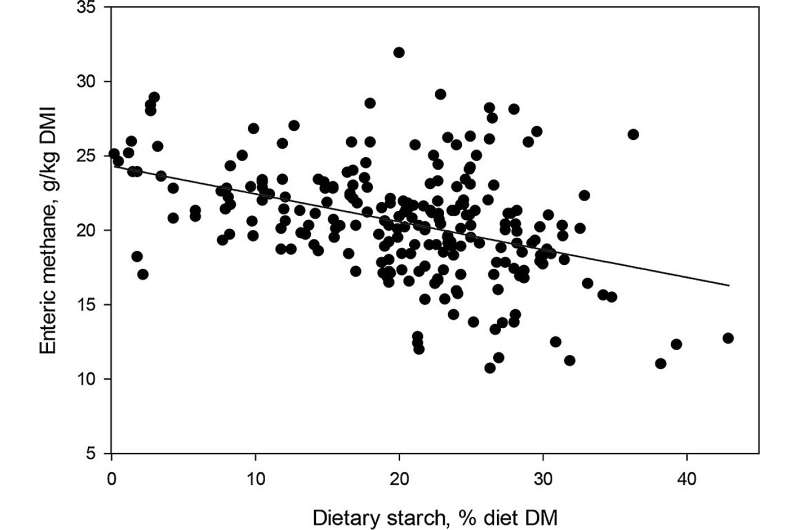This article has been reviewed according to Science X's editorial process and policies. Editors have highlighted the following attributes while ensuring the content's credibility:
fact-checked
peer-reviewed publication
trusted source
proofread
Dairy nutrition is leading the sustainability charge

Research into reducing greenhouse gas emissions from livestock has increased exponentially as the dairy and agriculture sectors work together toward shared sustainability and efficiency goals. While this progress has been made in all areas of dairy science research, from genetics to animal health and welfare, dairy nutrition has emerged as a particularly impactful area for emission reduction.
In a new invited review in the Journal of Dairy Science, a preeminent voice in sustainability and dairy nutrition synthesizes what we know so far and reveals that new nutrition strategies could potentially slash methane emissions by a staggering 60% in the coming years.
Methane (both enteric methane produced during digestion and methane from manure) is the critical greenhouse gas that makes up most of the dairy industry's environmental footprint. The invited review's author, Alexander Hristov, Ph.D., PAS, Distinguished Professor of Dairy Nutrition, Department of Animal Science, The Pennsylvania State University, and recipient of the 2024 Journal of Dairy Science Highly Cited Award explains, "There are two main ways to tackle enteric methane emissions through nutrition: adjusting an animal's diet or adding in specific new ingredients."
Dr. Hristov's review provides an insightful overview of what we know now about both options, where additional research is needed, and which methane-reduction pathways might be most practical and achievable for the future.
The review begins with the latest findings on diet reformulation, including adjusting concentrate feeds, feeding corn versus grass and legume silage, and using alternative forages such as sorghum or plantain. With all of these options available, can diet changes have a real impact on methane emissions? The answer, asserts Dr. Hristov, isn't simple or one size fits all.
Dr. Hristov says, "Diet reformulation depends on a farm's unique scenario to be an effective tool. If a dairy has room for efficiency and productivity improvements, for example, balancing diets can be helpful."
However, this approach is less practical in intensive dairy production systems, where nutritional professionals formulate the diets and producers have efficiency dialed in. In those dairy systems, Dr. Hristov notes, "It may be difficult to find specific feeds that can have a substantial and measurable impact on methane emissions."
That leaves feed additives, new ingredients supplemented in small amounts to a dairy cow's existing diet, to reduce methane produced during digestion. Based on existing research, the most promising additives are seaweeds and 3-nitrooxypropanol (3-NOP).
Red seaweed varieties, for example, contain bromoform, an active compound that has been effective in reducing methane emissions in several studies. Dr. Hristov adds, "Bromoform appears to be able to achieve a 30% to 50% emissions reduction, but whether this effect can be applied broadly and consistently needs more research."
The strongest feed additive contender to emerge is 3-NOP. According to Dr. Hristov, "Its efficacy has been proven in numerous controlled and independent experiments, and 3-NOP is currently the only available option headed to market for dairy operations looking to use additives to reduce emissions."
Dr. Hristov also highlights two areas that could benefit from more research as the dairy sector works to move the sustainability needle forward: reducing methane emissions from cow manure and studying whether nutrition strategies can be paired together synergistically.
Dr. Hristov comments, "In theory, practices with different modes of reducing methanogens could work together to boost overall mitigation."
The article cites a best-case scenario in the literature in which a 20% to 30% reduction by a feed additive could be paired with another 10% to 20% reduction from a second feed additive, plus, perhaps, another 5% to 10% from improvements in forage quality and diet manipulation, adding up to a substantial overall impact in lowering methane.
While Dr. Hristov was clear that the pathways toward dairy sustainability are still in flux—and that no one solution will work for every dairy system and every farm—advances in dairy nutrition will be an essential component in the methane-reduction mix.
He concludes, "If currently available mitigation practices prove to deliver consistent results, and novel, potent, and safe strategies are discovered, nutrition alone can deliver up to a 60% reduction in enteric methane emissions and pave the way for a more sustainable dairy sector."
More information: A.N. Hristov, Invited review: Advances in nutrition and feed additives to mitigate enteric methane emissions, Journal of Dairy Science (2024). DOI: 10.3168/jds.2023-24440
Journal information: Journal of Dairy Science
Provided by Elsevier





















